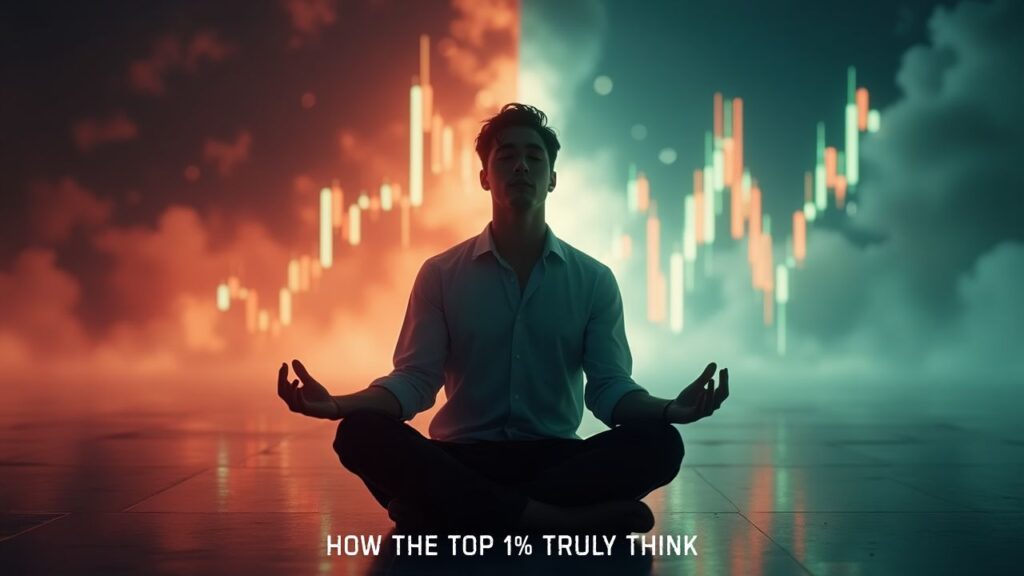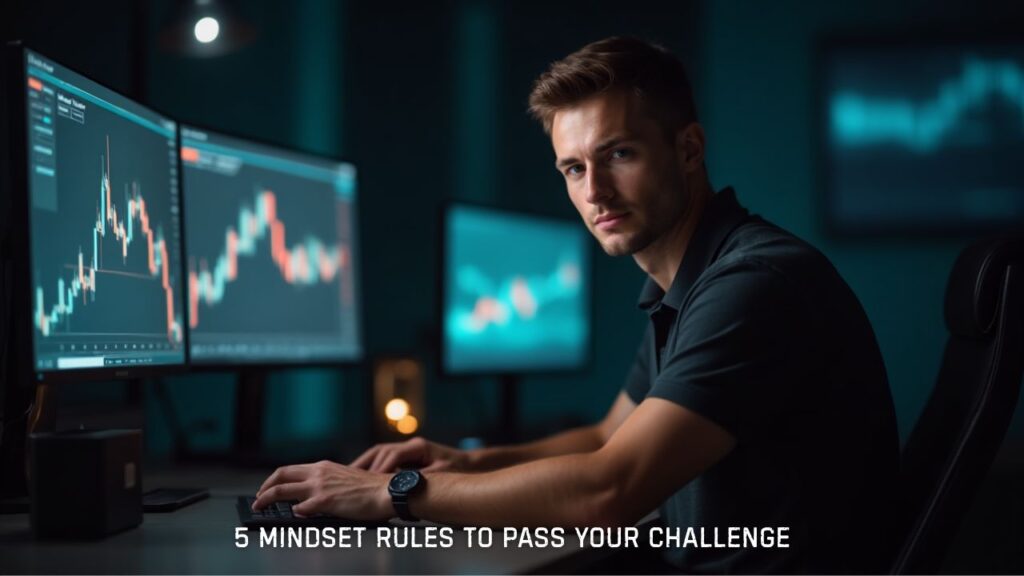Cryptocurrency trading psychology isn’t just a buzzword, it’s the hidden edge that separates consistent winners from emotional wrecks. You can have the most advanced charting software, dozens of indicators, and every trading strategy memorized. But if you panic sell the dip or chase a pump out of FOMO, none of that matters.
Here’s the thing: the biggest battle in trading isn’t against the market. It’s against your own mind.
In crypto trading, emotional discipline is your real advantage, not RSI, not Fibonacci levels, not price action patterns. In a 24/7 market that never sleeps, the emotional rollercoaster never stops: greed, fear, hope, regret, repeat.
This guide breaks down how mastering cryptocurrency trading psychology builds the mental clarity and subconscious strength needed to win in chaos and why your emotions might be your most powerful trading tool.
Why Technical Analysis Isn’t Enough
Charts are a map, not the territory. In the heat of a volatile move, even perfect setups fail when emotions take control.
You’ve probably been there:
- You see the setup but hesitate.
- You exit too early, afraid of losing profits.
- You jump in too late because of FOMO.
It’s not your strategy that’s broken, it’s your trading mindset.
Cryptocurrency trading psychology isn’t a luxury; it’s the foundation. Because in real time, your results depend more on emotional discipline than on technical skill.
The Unique Psychological Traps of Crypto Traders
Trading crypto is a different beast. Here are three major traps that test your mindset more than any chart.
The 24/7 Market Stress
Crypto never sleeps. That means your anxiety doesn’t either.
You wake up at 3 a.m. to check Bitcoin.
You feel pressure to trade every move.
You fear missing “the next big pump.”
This constant vigilance leads to burnout, compulsive decisions, and fatigue, the enemies of emotional control.
Hype Cycles and Social Media Pressure
Every other tweet screams:
“$SOL to $1000! Don’t miss it!”
This sparks FOMO, regret, and eventually revenge trading.
Social media amplifies herd behavior and unrealistic expectations. You’re not just trading against charts, you’re trading against the narrative.
Volatility as an Addiction
Huge wins and losses can trigger the same dopamine hits as gambling. Over time, you begin to crave volatility, trading not for profit, but for excitement.
That’s when the market punishes you hardest.
Case Study: Two Traders, Same Chart. Different Results
Imagine two traders staring at the same Ethereum breakout.
- Trader A has strong emotional discipline. She waits for confirmation, uses stop-losses, and sizes positions logically.
- Trader B jumps in impulsively after a tweet, adds more as price drops, then exits in panic.
Same chart. Same opportunity. Completely different outcomes.
The difference isn’t in skill, it’s in psychology. The calm trader plays probabilities. The emotional trader plays survival.
In crypto, your reactions are your edge.
The Subconscious Mind. Your Hidden Trading Partner
Every belief, fear, and reaction you bring to a trade comes from one place: your subconscious mind.
It runs 95% of your daily behavior. It stores everything from childhood beliefs about money to the trauma of past trading losses.
If you were criticized for losing money growing up, you might subconsciously fear risk.
If you once hit a lucky win on a meme coin, you might keep chasing the high.
Your crypto trader mindset isn’t just about willpower, it’s about reprogramming your subconscious.
How to Reprogram Your Subconscious for Trading Success
- Daily Affirmations: Reinforce identity-based beliefs like “I am a calm, disciplined trader.”
- Visualization: Before trading, picture yourself following your plan with patience, even through losses.
- Self-Talk Awareness: Catch limiting thoughts like “I always mess up.” Replace with “Every trade is feedback.”
- Meditation: Practicing presence helps silence the overthinking that leads to impulsive trades.
As Joseph Murphy said, “The subconscious mind is like fertile soil. Plant disciplined thoughts and you’ll harvest calm decisions.”
Developing Emotional Discipline in Crypto Trading
So how do you build real control, the kind that lasts through volatility?
Keep a Trading Journal
Track not just trades, but emotions.
Write down:
- Why did you enter?
- What did you feel?
- Did you follow your plan?
Over time, you’ll spot emotional patterns, maybe you overtrade when bored, or FOMO after losses. Awareness is your first tool of change.
Create Rules and Automate Decisions
Rules remove emotion. Example:
- No trade below 1:3 risk-to-reward.
- Stop trading after 3 consecutive losses.
- Only trade between 9 a.m. and 3 p.m.
These boundaries act as emotional guardrails.
3. Build a Reset Routine
Start your day with deep breathing or gratitude journaling.
Take breaks after stressful trades.
End your day reflecting, not reacting.
This is how you build emotional discipline in trading, one routine at a time.
Real-Life Crypto Scenarios and Mindset Fixes
Scenario 1: The “Pump and Panic”
You FOMO into a parabolic move. It crashes.
Fix: Wait 30 minutes before reacting. Let volatility settle.
Scenario 2: The “Loss Spiral”
You lose. You double down. You lose again.
Fix: Step away for 24 hours. Clarity comes with distance.
Scenario 3: The “Sleepless Cycle”
You trade at 2 a.m., skip rest, and overtrade.
Fix: Set crypto trading hours. Sleep sharpens judgment more than screens.
The 3-Step Crypto Trading Mindset Framework
Use this system to regain emotional control:
Observe: Track emotions, not just trades.
Interrupt: Use alarms, checklists, or breathwork when emotions spike.
Rewire: Replace impulsive reactions with rituals and affirmations.
Every trade is emotional training.
Tools for Emotional Mastery in Trading
- Apps: Journaling platforms like Edgewonk, Tradezella, or even Notion templates.
- Books: The Psychology of Money by Morgan Housel and Trading in the Zone by Mark Douglas.
- Communities: Avoid hype groups. Join ones focused on emotional resilience and skill building.
Check out our related post: How to Stay Calm During Drawdowns
Key Takeaways
- Success in crypto trading depends more on mindset than technical skill.
- Your subconscious mind controls your emotional reactions, reprogram it with intention.
- Journaling, boundaries, and rituals form your emotional foundation.
- Indicators fail when your emotions dominate.
- The real edge? Calm under chaos.
Cryptocurrency trading psychology is the hidden skill that separates emotional chaos from consistent profits. It’s the discipline to stay calm when prices crash and patient when they soar. When you master your emotions, you stop reacting to the market and start leading it.
Emotional Trader vs Mindful Trader
| Behavior | Emotional Trader | Mindful Trader |
|---|---|---|
| Reaction to Loss | Takes revenge trades | Reflects and resets with clarity |
| Reaction to Hype | Buys impulsively | Waits for confirmation |
| Decision Process | Emotion-driven | Logic and structure |
| Routine | Random and reactive | Fixed and focused |
| Self-Talk | “I always lose” | “Every trade teaches me” |
| Long-Term Result | Burnout | Consistent growth |
Master the Mind, Master the Market
Crypto trading isn’t about catching the next 100x coin, it’s about surviving long enough to grow consistently.
The truth? Markets will always test you. The difference between breaking and thriving lies in your emotional mastery.
You don’t just need better charts.
You need a better relationship with your mind.
Master your subconscious. Master your reactions. And you’ll master the market.
If you want weekly insights that sharpen your mindset, cut through emotional noise, and help you trade with clarity, join The Reborn Trader Newsletter. I share premium lessons, mental frameworks, and behind-the-scenes breakdowns, all for free.
It’s the fastest way to level up your discipline, emotional control, and consistency.
Subscribe here and get the next issue delivered straight to your inbox.
FAQs
What is cryptocurrency trading psychology?
It’s how emotions and subconscious patterns shape trading decisions. Mastering it helps you trade logically not impulsively.
Why is emotional discipline more important than strategy?
Because strategy fails under stress. Discipline keeps you consistent when the market tests your patience.
How can I control emotions while trading crypto?
Through journaling, rules, and mindfulness. Awareness turns emotion into data.
How does the subconscious mind affect trading?
It drives habits and beliefs. Reprogram it with affirmations, visualization, and meditation.




